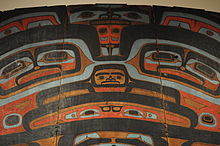
William Ronald Reid Jr. was a Haida Canadian artist whose works include jewelry, sculpture, screen-printing, and paintings. Producing over one thousand original works during his fifty-year career, Reid is regarded as one of the most significant Northwest Coast artists of the late twentieth century.
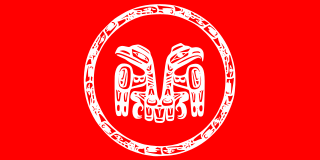
Haida are an indigenous group who have traditionally occupied Haida Gwaii, an archipelago just off the coast of British Columbia, Canada, for at least 12,500 years.

Totem poles are monumental carvings found in western Canada and the northwestern United States. They are a type of Northwest Coast art, consisting of poles, posts or pillars, carved with symbols or figures. They are usually made from large trees, mostly western red cedar, by First Nations and Indigenous peoples of the Pacific Northwest Coast including northern Northwest Coast Haida, Tlingit, and Tsimshian communities in Southeast Alaska and British Columbia, Kwakwaka'wakw and Nuu-chah-nulth communities in southern British Columbia, and the Coast Salish communities in Washington and British Columbia.

The Museum of Anthropology at the University of British Columbia (UBC) campus in Vancouver, British Columbia, Canada displays world arts and cultures, in particular works by First Nations of the Pacific Northwest. As well as being a major tourist destination, MOA is a research and teaching museum, where UBC courses in art, anthropology, archaeology, conservation, and museum studies are given. MOA houses close to 50,000 ethnographic objects, as well as 535,000 archaeological objects in its building alone.
Masterfully designed canoes of many sizes and forms were made on the Pacific Northwest coast of North America. They were the main form of transportation for the indigenous people of the area until long after European colonisation. In recent years, the craft of canoe-making has been revived, and a few have been built by a number of the native nations. Like those made in traditional times, they have proved eminently seaworthy.

The Heiltsuk or Haíɫzaqv, sometimes historically referred to as Bella Bella, are an Indigenous people of the Central Coast region in British Columbia, centred on the island community of Bella Bella. The government of the Heiltsuk people is the Heiltsuk Nation, though the term is also used to describe the community. Its largest community is Bella Bella.
Wilson Duff was a Canadian archaeologist, cultural anthropologist, and museum curator.
Freda Diesing was a Haida woman of the Sadsugohilanes Clan, one of very few female carvers of Northwest Coast totem poles and a member of the Council of the Haida Nation of British Columbia, Canada. Her Haida name is Skil Kew Wat, meaning "magical little woman."
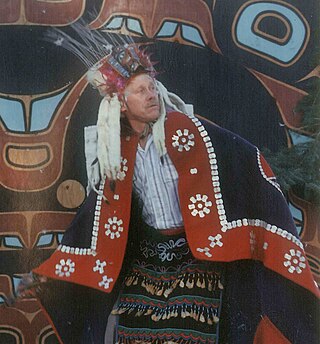
Oscar William Holm Jr. was an American art historian and author, focused on Indigenous Northwest Coast art. He created artworks and taught Northwest Coast style, including formline design. He was Professor Emeritus of Art History, and Curator Emeritus of Northwest Coast Indian Art at the Burke Museum of Natural History and Culture and occasionally lectured at the University of Washington in Seattle.

Northwest Coast art is the term commonly applied to a style of art created primarily by artists from Tlingit, Haida, Heiltsuk, Nuxalk, Tsimshian, Kwakwaka'wakw, Nuu-chah-nulth and other First Nations and Native American tribes of the Northwest Coast of North America, from pre-European-contact times up to the present.
Marcia Crosby is a Canadian writer, art historian, and educator with Tsimshian-Haida ethnicity.
Michael Nicoll Yahgulanaas is a visual artist, author, and public speaker. His work has been seen in public spaces, museums, galleries and private collections across globe. Institutional collections include the British Museum, Metropolitan Museum of Art, Seattle Art Museum, Vancouver Art Gallery, and the Humboldt Forum.
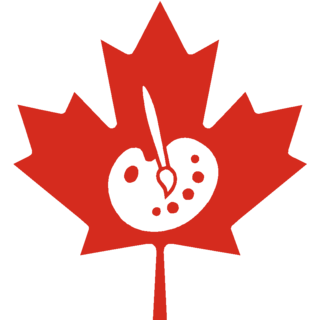
Canadian art refers to the visual as well as plastic arts originating from the geographical area of contemporary Canada. Art in Canada is marked by thousands of years of habitation by Indigenous peoples followed by waves of immigration which included artists of European origins and subsequently by artists with heritage from countries all around the world. The nature of Canadian art reflects these diverse origins, as artists have taken their traditions and adapted these influences to reflect the reality of their lives in Canada.

Delores E. Churchill is a Native American artist of Haida descent. She is a weaver of baskets, hats, robes, and other regalia, as well as leading revitalization efforts for Haida, her native language.
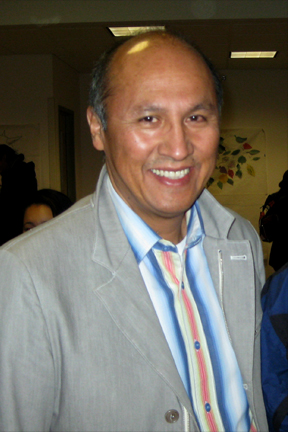
Gerald Raymond McMaster is a curator, artist, and author and a Plains Cree member of the Siksika Nation. McMaster is a professor at OCAD University and is the adjunct curator at the Remai Modern in Saskatoon, Saskatchewan.

James Hart is a Canadian and Haida artist and a chief of the Haida Nation.
Lawrence Paul Yuxweluptun is a Cowichan/Syilx First Nations contemporary artist from Canada. His paintings employ elements of Northwest Coast formline design and Surrealism to explore issues as environmentalism, land ownership, and Canada's treatment of First Nations peoples.
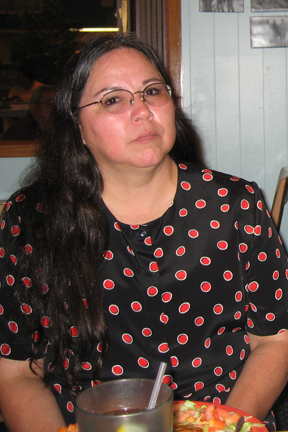
Lisa Telford is a Git'ans Git'anee Haida weaver who creates contemporary garments, shoes and other objects using Northwest Coast style weaving techniques. Her work serves as a commentary on Native identity, stereotypes and fashion.

The Raven and the First Men is a sculpture by Haida artist Bill Reid. It depicts the Haida creation myth. It was carved from a single block of laminated yellow cedar, beginning in the fall of 1978, and took two years to complete, with work completing on April 1, 1980. Raven and the First Men is depicted on the reverse of the former Canadian twenty dollar bill of the Canadian Journey series.
Evelyn Vanderhoop is a Native American artist of Haida descent who is both a watercolorist and master weaver.
